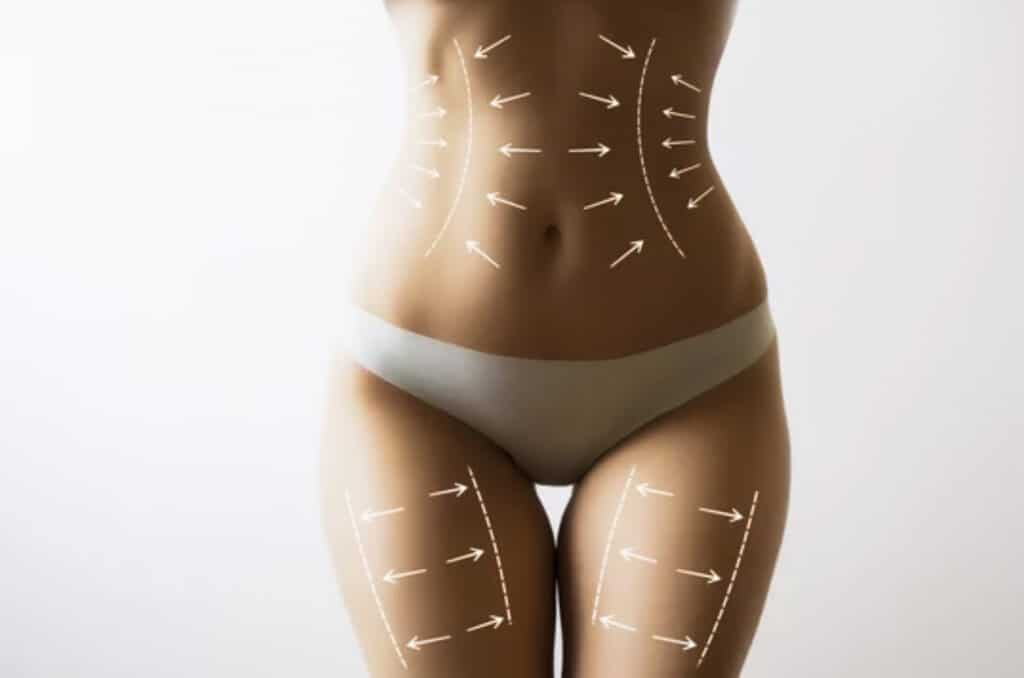Liposuction
- April 15, 2023
Discover the benefits of liposuction for body contouring and fat removal. Explore expert advice, latest techniques, and recovery tips for a slimmer, more confident you.
AVERAGE COST
$2,000 to $7,000
PROCEDURE TIME
1 to 4 Hours
BACK TO WORK
1 to 2 Weeks
FULL RECOVERY
1 to 4 Weeks
Get In Touch
We will contact you as soon as possible!









What is a Liposuction?
What is the process of Liposuction surgery?
The liposuction surgery process typically involves the following steps:
Prior to surgery, you will have a consultation with a plastic surgeon to discuss your goals, medical history, and expectations. The surgeon will evaluate if you’re a suitable candidate for the procedure and help you decide on the appropriate treatment plan.
On the day of the surgery, anesthesia will be administered to ensure your comfort during the procedure. This can be local, regional, or general anesthesia, depending on the extent of the liposuction and the surgeon’s recommendation.
The surgeon will make small, inconspicuous incisions in the targeted areas. The size and location of incisions depend on the specific technique used and the areas being treated.
A thin, hollow tube called a cannula is inserted through the incisions to break up and loosen the fat deposits. The cannula is moved back and forth in a controlled manner to dislodge the fat, which is then suctioned out using a surgical vacuum or syringe attached to the cannula.
Once the desired amount of fat has been removed, the incisions may be closed using sutures or left open to allow for drainage. Compression garments or elastic bandages are often applied to help reduce swelling and support the treated areas during the healing process.
The recovery period will vary depending on the extent of the surgery and the individual patient. Swelling, bruising, and soreness are common after liposuction, but these side effects usually subside within a few weeks. Most patients can return to work and light activities within a week or two, while more strenuous activities may be resumed after 4-6 weeks or as advised by the surgeon.
The final results of liposuction may not be immediately visible due to postoperative swelling. However, as the swelling subsides over the following weeks and months, the improved body contour will become more apparent. It is important to maintain a healthy lifestyle, including regular exercise and a balanced diet, to preserve the long-term results of the procedure.
Are there any non-surgical alternatives for liposuction?
Yes, there are several non-surgical alternatives to liposuction that can help reduce stubborn fat deposits and improve body contour. These non-invasive treatments often use different technologies to target and break down fat cells, which are then naturally eliminated by the body. Some popular non-surgical alternatives include:
CoolSculpting: Also known as cryolipolysis, CoolSculpting uses controlled cooling to freeze and destroy fat cells without damaging the surrounding tissues. The body gradually eliminates the destroyed fat cells over time, resulting in a more contoured appearance.
SculpSure: This treatment uses laser technology to heat and destroy fat cells, which are then naturally eliminated by the body. SculpSure is suitable for targeting smaller areas of stubborn fat and typically requires multiple sessions to achieve optimal results.
UltraShape: UltraShape employs ultrasound technology to target and disrupt fat cells, which are then processed and removed by the body. This non-invasive treatment is generally painless and does not require any downtime.
Vanquish: Vanquish uses radiofrequency (RF) energy to heat and destroy fat cells, causing them to break down and be naturally eliminated by the body. This treatment is ideal for larger areas and offers a non-surgical option for fat reduction.
Emsculpt: While Emsculpt primarily focuses on muscle toning and strengthening, it can also help reduce fat in the treated area. This treatment uses electromagnetic energy to stimulate muscle contractions, which helps build muscle and burn fat simultaneously.
It’s important to note that these non-surgical alternatives are not as effective as liposuction in terms of fat removal, and they may require multiple sessions to achieve desired results. Additionally, these treatments are best suited for individuals with mild to moderate fat deposits and are not a substitute for weight loss or a healthy lifestyle. Consult with a qualified medical professional to determine which treatment option is best for your specific needs and goals.
Are there different techniques used for liposuction surgery?
Yes, there are several different techniques used for liposuction surgery, each with its unique approach to fat removal. Some of the most common techniques include:
Tumescent Liposuction: This is the most popular and traditional liposuction technique. It involves injecting a large volume of a solution containing saline, lidocaine (a local anesthetic), and epinephrine (a blood vessel constrictor) into the targeted areas. This solution causes the fat to swell and become firm, making it easier to remove. The added lidocaine minimizes pain, while epinephrine helps reduce bleeding and bruising.
Power-Assisted Liposuction (PAL): In this technique, the cannula used to remove fat is mechanically powered, allowing for faster and more precise fat removal. The vibrating action of the cannula helps break up fat deposits more efficiently, often resulting in less trauma to the surrounding tissues and a shorter recovery time.
Ultrasound-Assisted Liposuction (UAL): UAL uses ultrasound energy to liquefy the fat cells before they are suctioned out. The cannula emits ultrasonic waves that break up and emulsify the fat, making it easier to remove. This technique is particularly useful for removing fat from fibrous areas, such as the upper back or male breast tissue, and can also help tighten the skin in some cases.
Laser-Assisted Liposuction (LAL): LAL, also known as SmartLipo or Laser Lipolysis, uses laser energy to liquefy fat cells before removal. The laser fiber is inserted through a small incision, and the heat generated by the laser helps to break down the fat and coagulate blood vessels, reducing bleeding and bruising. This technique may also stimulate collagen production, resulting in some skin tightening.
Radiofrequency-Assisted Liposuction (RFAL): This technique uses radiofrequency energy to heat and liquefy fat before it is suctioned out. The RF energy also helps tighten the skin by stimulating collagen production, making it a good option for patients with mild to moderate skin laxity.
Each liposuction technique has its advantages and potential drawbacks, and the best method for an individual patient depends on factors such as the area being treated, the amount of fat to be removed, and the patient’s medical history. A qualified plastic surgeon will assess your specific needs and goals and recommend the most suitable liposuction technique for your situation.
How does liposuction surgery affect overall body proportions?
Liposuction surgery can have a significant impact on overall body proportions by removing stubborn fat deposits from targeted areas that are resistant to diet and exercise. By sculpting and contouring these areas, liposuction can create a more balanced, aesthetically pleasing, and harmonious body shape.
Some common areas where liposuction is performed include the abdomen, hips, thighs, buttocks, arms, and neck. When fat is removed from these areas, it can lead to an improved silhouette and a more proportionate appearance. For example, removing excess fat from the waist can create an hourglass shape in women or a more toned and athletic appearance in men. Similarly, liposuction on the thighs can help create a more defined separation between the thighs and buttocks, resulting in a more balanced lower body.
It is essential to work with an experienced plastic surgeon who understands body proportions and aesthetics. They will help you determine the most appropriate treatment plan to achieve your desired results while maintaining natural-looking proportions.
It’s also important to note that liposuction is not a weight-loss method and should not be used as a substitute for a healthy lifestyle. Maintaining a stable weight, eating a balanced diet, and engaging in regular exercise will help you preserve the improved proportions and results achieved through liposuction surgery.
Is there an age limit for undergoing liposuction surgery?
There is no specific age limit for undergoing liposuction surgery. However, age can be an important factor in determining whether an individual is a suitable candidate for the procedure. Key factors that plastic surgeons consider when evaluating a patient’s eligibility for liposuction include:
Physical health: Good overall health is essential for any surgical procedure, including liposuction. Older patients may have a higher risk of complications due to age-related health issues such as hypertension, diabetes, or heart disease. A thorough medical evaluation is necessary to determine if an older patient is healthy enough to undergo liposuction.
Skin elasticity: As people age, their skin loses elasticity, which can affect the results of liposuction. Younger patients typically have better skin elasticity, allowing the skin to better conform to the new body contours after fat removal. Older patients with diminished skin elasticity may experience loose or sagging skin after liposuction, potentially requiring additional procedures like skin tightening or body lift surgery to achieve optimal results.
Realistic expectations: It’s important for patients of any age to have realistic expectations about the outcomes of liposuction surgery. Older patients should understand that while liposuction can improve their body contours, it cannot reverse the natural aging process or completely restore a youthful appearance.
Stable weight: Liposuction is not a weight-loss solution, so it’s crucial for patients to have a stable weight before undergoing the procedure. Significant weight fluctuations after liposuction can negatively impact the results.
While there is no specific age limit for liposuction, the decision to undergo surgery should be made in consultation with a qualified plastic surgeon who will evaluate the patient’s overall health, skin quality, and goals to determine if they are a suitable candidate for the procedure.
Can liposuction surgery be reversed or adjusted if complications arise or the patient is unsatisfied with the results?
Liposuction is a permanent fat removal procedure, and reversing it is not possible in the sense of putting the removed fat back into the treated areas. However, if complications arise or a patient is unsatisfied with the results, there are options available to address these issues.
Revision liposuction: If the initial liposuction procedure results in uneven contours, residual fat deposits, or overcorrection, a revision liposuction may be performed to correct these issues. In some cases, the surgeon might remove additional fat from the treated or adjacent areas to achieve a more balanced and desirable result. It’s essential to wait until the body has fully healed from the initial procedure (usually at least six months) before undergoing revision liposuction.
Fat grafting: If the initial liposuction procedure results in excessive fat removal or indentations, fat grafting can be a solution. Fat grafting, also known as autologous fat transfer, involves harvesting fat from another part of the patient’s body, purifying it, and then injecting it into the areas that require additional volume or correction. This can help restore a smoother, more natural-looking contour.
Skin tightening or body lift procedures: If loose or sagging skin is a concern after liposuction, particularly in older patients or those with poor skin elasticity, additional procedures such as a body lift or skin tightening treatments may be necessary to achieve optimal results. These procedures can help remove excess skin and improve overall body contours.
Non-surgical treatments: In some cases, non-surgical treatments, such as radiofrequency or ultrasound-based devices, may be used to improve skin texture, tighten skin, or address minor irregularities after liposuction.
It’s essential to choose a skilled and experienced plastic surgeon to minimize the risk of complications and ensure the best possible outcome from liposuction. If complications do arise or you are unsatisfied with the results, discuss your concerns with your surgeon, who will help determine the most appropriate course of action to address the issues.
How does a patient's psychological well-being impact their experience with liposuction surgery?
A patient’s psychological well-being plays a significant role in their experience with liposuction surgery, both during the decision-making process and throughout the recovery and healing stages. Here are some ways psychological well-being can impact a patient’s liposuction experience:
Realistic expectations: Patients with a healthy psychological outlook are more likely to have realistic expectations about the results of liposuction surgery. They understand that liposuction is a body contouring procedure and not a weight-loss solution or a cure for emotional or self-esteem issues.
Decision-making: A patient with good psychological well-being is better equipped to make informed decisions about whether to undergo liposuction surgery. They can carefully weigh the potential benefits and risks, considering factors such as cost, recovery time, and potential complications.
Coping with stress and anxiety: Surgery can be a stressful experience for anyone, and patients with good psychological health are typically better equipped to manage preoperative anxiety and postoperative stress. They can utilize healthy coping mechanisms and seek support from friends, family, or mental health professionals if needed.
Recovery and healing: A positive mindset and strong psychological well-being can contribute to a smoother recovery process. Patients who are emotionally resilient may find it easier to manage pain, discomfort, and the temporary limitations on daily activities following surgery. They are also more likely to follow postoperative care instructions, which can lead to better healing and overall outcomes.
Satisfaction with results: Patients with a healthy psychological outlook are more likely to be satisfied with the results of liposuction surgery. They can appreciate the improvements in body contour without expecting perfection or a complete transformation of their self-image.
It’s crucial for plastic surgeons to evaluate a patient’s psychological well-being during the consultation process to ensure they are suitable candidates for liposuction. In some cases, a surgeon may recommend that a patient seeks psychological counseling or addresses any underlying mental health issues before undergoing the procedure. This helps ensure the best possible experience and outcomes for the patient.
Are there any advancements in the field of (liposuction surgery?
There have been numerous advancements in the field of liposuction surgery over the years, making the procedure safer, more efficient, and providing better results. Some of the recent and ongoing advancements in liposuction include:
Improved techniques: Innovations in liposuction techniques, such as ultrasound-assisted liposuction (UAL), laser-assisted liposuction (LAL), and radiofrequency-assisted liposuction (RFAL), offer more precise fat removal and reduced trauma to the surrounding tissues. These advancements can lead to faster recovery times and minimized side effects, such as bruising and swelling.
Enhanced patient safety: Developments in anesthesia, surgical instruments, and surgical protocols have improved patient safety during liposuction procedures. For example, the tumescent technique, which involves injecting a large volume of fluid into the treatment area, has significantly reduced blood loss and minimized the need for general anesthesia.
Body contouring combinations: Combining liposuction with other body contouring procedures, such as fat grafting, tummy tucks, or body lifts, can provide more comprehensive and satisfying results for patients. These combinations allow surgeons to address multiple aesthetic concerns in a single treatment plan, improving overall body proportions and contours.
Non-surgical alternatives: Ongoing advancements in non-surgical fat reduction technologies, such as CoolSculpting, SculpSure, and UltraShape, offer patients less invasive options for addressing stubborn fat deposits. While these alternatives may not provide the same level of fat removal as liposuction, they can still offer noticeable improvements in body contour without the need for surgery.
Personalized treatment plans: Advances in imaging technology and surgical planning tools have enabled plastic surgeons to create more personalized treatment plans for liposuction patients. This allows for more accurate and precise fat removal, resulting in better aesthetic outcomes and higher patient satisfaction.
Regenerative medicine: Research in the field of regenerative medicine is exploring the potential use of stem cells and growth factors obtained from adipose (fat) tissue during liposuction procedures. This has the potential to promote better healing, minimize scarring, and even enhance skin quality.
As the field of liposuction surgery continues to evolve, it’s expected that further advancements will be made in terms of technique, patient safety, and outcomes. These innovations will help provide even better results for patients seeking to improve their body contours through liposuction.
Who is a candidate for liposuction surgery?
Liposuction is a body contouring procedure that can help patients achieve a more balanced and proportionate appearance by removing stubborn fat deposits that are resistant to diet and exercise. The ideal candidate for liposuction surgery typically meets the following criteria:
Good overall health: Candidates should be in good general health, without any significant medical conditions that could increase the risk of complications during surgery or impair the healing process. Conditions like uncontrolled diabetes, heart disease, or a weakened immune system may make liposuction unsuitable for some individuals.
Stable weight: Liposuction is not a weight-loss solution, so candidates should be at or near their ideal body weight with a BMI (body mass index) of 30 or below. Maintaining a stable weight for several months before the procedure is also crucial, as significant weight fluctuations can affect the long-term results of liposuction.
Stubborn fat deposits: Candidates should have localized areas of stubborn fat that are resistant to diet and exercise, such as the abdomen, hips, thighs, buttocks, arms, or neck. Liposuction is most effective when targeting specific problem areas to create a more balanced and proportionate appearance.
Good skin elasticity: Liposuction works best on patients with good skin elasticity, as the skin will be better able to contract and conform to the new body contours after fat removal. Patients with poor skin elasticity or significant loose skin may not achieve optimal results with liposuction alone and might require additional skin-tightening procedures.
Realistic expectations: Ideal candidates should have realistic expectations about the outcomes of liposuction surgery. They should understand that while liposuction can provide significant improvements in body contour, it will not result in a perfect body or address issues related to self-esteem or body image.
Non-smoker: Smoking can increase the risk of complications during surgery and impair the healing process. It’s essential for candidates to quit smoking several weeks before and after the procedure to ensure a successful recovery.
A qualified plastic surgeon will evaluate your specific needs, goals, and medical history during a consultation to determine if you are a suitable candidate for liposuction surgery.
What are the long-term effects and potential complications of liposuction surgery?
Liposuction is generally considered a safe and effective body contouring procedure, but as with any surgery, there are potential risks and complications. The long-term effects of liposuction are typically positive when performed by an experienced and qualified plastic surgeon, with patients enjoying improved body contours and a more proportionate appearance. However, it is important to be aware of the potential complications that may arise:
Infection: Although rare, infection can occur after liposuction surgery. It is essential to follow your surgeon’s postoperative care instructions, including proper wound care and hygiene, to minimize the risk of infection.
Hematoma or seroma: Hematomas (collections of blood) or seromas (collections of fluid) may form under the skin in the treated areas. Most cases resolve on their own or with minimal intervention, but in some instances, they may require additional treatment or drainage.
Scarring: While liposuction incisions are generally small and well-hidden, some scarring is inevitable. The extent of scarring varies depending on individual factors, such as genetics, skin type, and healing ability. Most scars fade over time and become less noticeable.
Irregularities or contour deformities: Uneven fat removal, poor skin elasticity, or healing complications can lead to irregularities, dimpling, or contour deformities in the treated areas. In some cases, revision surgery or additional treatments may be necessary to correct these issues.
Skin discoloration: Temporary changes in skin color, such as bruising or hyperpigmentation, can occur after liposuction. These changes typically resolve over time, but in rare cases, they may persist or become permanent.
Nerve damage or numbness: Temporary or, in rare cases, permanent nerve damage can occur, leading to numbness or changes in sensation in the treated areas.
Thrombosis or embolism: Although rare, there is a risk of blood clots forming in the deep veins of the legs (deep vein thrombosis) or a clot traveling to the lungs (pulmonary embolism), which can be life-threatening. To minimize this risk, patients are encouraged to move and walk as soon as possible after surgery and follow their surgeon’s guidelines for postoperative activity.
Changes in skin sensation: Some patients may experience temporary or permanent changes in skin sensation after liposuction, including numbness or tingling in the treated areas.
To minimize the risk of complications, it is essential to choose an experienced and board-certified plastic surgeon to perform your liposuction procedure. Additionally, following your surgeon’s preoperative and postoperative instructions will help ensure a successful outcome and reduce the risk of complications.
How successful and safe is liposuction surgery?
Liposuction surgery is generally considered to be both successful and safe when performed by a qualified and experienced plastic surgeon. The success of liposuction is often measured by patient satisfaction with the improvements in body contour and proportions, as well as the reduction of stubborn fat deposits that were resistant to diet and exercise.
The safety of liposuction has improved significantly over the years due to advancements in surgical techniques, anesthesia, and patient care protocols. Some factors that contribute to the safety and success of liposuction surgery include:
Qualified plastic surgeon: Choosing a board-certified plastic surgeon with extensive experience in liposuction ensures that you receive the highest standard of care, minimizing the risk of complications and optimizing the chances of a successful outcome.
Appropriate patient selection: A thorough evaluation and consultation with a plastic surgeon help determine if a patient is a suitable candidate for liposuction, taking into account their overall health, skin quality, and expectations.
Surgical technique: Advances in liposuction techniques, such as tumescent liposuction, ultrasound-assisted liposuction (UAL), laser-assisted liposuction (LAL), and radiofrequency-assisted liposuction (RFAL), have reduced the risks associated with the procedure and improved patient outcomes.
Anesthesia: The use of appropriate anesthesia, such as local or general anesthesia depending on the extent of the procedure, plays a significant role in patient safety and comfort during liposuction surgery.
Postoperative care: Following your surgeon’s postoperative instructions, including wound care, activity restrictions, and compression garments, helps minimize the risk of complications, promotes healing, and ensures a successful recovery.
While liposuction is generally safe and successful, it is important to remember that, as with any surgery, there are inherent risks and potential complications. Discussing your concerns and expectations with your plastic surgeon will help ensure that you make an informed decision about whether liposuction is the right choice for you.
How much does liposuction surgery cost?
The cost of liposuction surgery can vary widely depending on several factors, including the surgeon’s experience, geographic location, and the extent of the procedure. In general, liposuction costs can range from $2,000 to $7,000 or more per treatment area. Some factors that influence the cost of liposuction include:
-
Surgeon’s fees: The fees for an experienced, board-certified plastic surgeon may be higher than those of a less experienced surgeon. It’s important to prioritize the surgeon’s expertise and qualifications over cost, as this will have a significant impact on the safety and success of your liposuction procedure.
-
Anesthesia fees: The type of anesthesia used for your liposuction procedure, whether it’s local or general anesthesia, will affect the overall cost. General anesthesia typically costs more than local anesthesia.
-
Facility fees: The cost of the surgical facility, whether it’s a hospital or an accredited outpatient surgical center, will also factor into the overall cost of your liposuction procedure.
-
Treatment areas: The number and size of the areas being treated will impact the cost of liposuction. Larger or multiple areas will require more time and effort, resulting in higher costs.
-
Complexity of the procedure: The complexity of the liposuction procedure, such as the technique used (e.g., traditional liposuction, ultrasound-assisted liposuction, or laser-assisted liposuction) and the volume of fat being removed, can also influence the cost.
-
Postoperative care: The cost of postoperative care, including medications, compression garments, and follow-up appointments, should also be considered when estimating the total cost of liposuction.
It’s important to note that liposuction is generally considered a cosmetic procedure, so it is not typically covered by health insurance. However, some plastic surgeons offer financing options or payment plans to help make the procedure more affordable for their patients. During your consultation, discuss the costs associated with liposuction and any available financing options with your plastic surgeon to ensure you have a clear understanding of the total expense.
Liposuction Financing
Liposuction is generally considered a cosmetic procedure, which means it is not typically covered by health insurance. However, many plastic surgeons offer financing options or payment plans to help make the procedure more affordable for their patients. Here are some common financing options for liposuction:
In-house financing: Some plastic surgeons offer in-house financing plans, allowing patients to pay for their procedure in monthly installments. These plans may have varying interest rates and payment terms, so it’s essential to discuss the details with your surgeon to understand the terms and conditions.
Medical credit cards: Medical credit cards, such as CareCredit, are specifically designed for healthcare expenses, including cosmetic procedures. These credit cards may offer promotional interest rates, deferred interest plans, or low fixed-rate plans for a specific period, depending on your creditworthiness. Make sure to review the terms and conditions carefully, as high-interest rates may apply after the promotional period.
Personal loans: You can also explore personal loans from banks or credit unions to finance your liposuction procedure. Personal loan interest rates and terms vary based on your credit history, income, and other financial factors.
Credit cards: Using a traditional credit card to finance your liposuction is another option. However, credit cards often have higher interest rates compared to other financing options, so it’s important to compare the costs and ensure you can make the necessary payments on time.
Payment plans: Some plastic surgeons offer payment plans that allow patients to pay for their procedure over time without interest. These plans may require an initial deposit, followed by regular payments until the full cost of the procedure is covered.
Health savings accounts (HSAs) or flexible spending accounts (FSAs): If you have an HSA or FSA through your employer, you may be able to use these funds for certain medically necessary liposuction procedures, such as those required to treat lipomas or lipodystrophy. Check with your plan administrator to determine if your liposuction procedure qualifies for HSA or FSA coverage.
When considering financing options for liposuction, it’s essential to carefully review the terms and conditions, interest rates, and any associated fees to ensure that you choose the best option for your financial situation. Discuss the costs and available financing options with your plastic surgeon during your consultation to make an informed decision about how to proceed.
Does Liposuction surgery is covered by insurance?
Liposuction is primarily considered a cosmetic procedure, which means it is generally not covered by health insurance. Most insurance plans only cover procedures deemed medically necessary, and since liposuction is typically performed to improve appearance rather than address a medical condition, it usually falls outside the scope of insurance coverage.
However, there are some exceptions where liposuction may be covered by insurance if it is deemed medically necessary. These cases are relatively rare and usually involve specific medical conditions, such as:
Lipomas: Benign fatty tumors that may require surgical removal, in which case liposuction may be covered as part of the treatment.
Lipodystrophy: A medical condition characterized by abnormal fat distribution in the body, which can lead to functional issues or complications. In some cases, liposuction may be considered medically necessary to alleviate symptoms or treat the condition.
Lymphedema: A chronic condition characterized by swelling due to the buildup of lymphatic fluid, typically affecting the arms or legs. In certain cases, liposuction may be considered a medically necessary treatment option to manage the symptoms of lymphedema.
Gynecomastia: Enlarged male breast tissue due to hormonal imbalances or other medical conditions. In some instances, insurance may cover liposuction if it is deemed medically necessary to treat gynecomastia.
If you believe your liposuction procedure may be medically necessary, it’s essential to discuss your situation with your plastic surgeon and contact your insurance provider to determine whether the procedure may be covered. Keep in mind that even if liposuction is considered medically necessary in your case, insurance coverage may only cover a portion of the costs, and you may still be responsible for copays, deductibles, or other out-of-pocket expenses.
How long does the Liposuction surgery last?
The duration of liposuction surgery can vary depending on several factors, such as the number of treatment areas, the amount of fat removed, the technique used, and the patient’s characteristics. Generally, liposuction procedures can last anywhere from 1 to 4 hours or more.
For smaller treatment areas or less extensive procedures, liposuction may take around 1 to 2 hours. In cases where multiple areas are being treated or a larger volume of fat is being removed, the surgery may take 3 to 4 hours or longer.
It’s important to note that the duration of the procedure may also be influenced by the specific liposuction technique used, such as tumescent liposuction, ultrasound-assisted liposuction (UAL), laser-assisted liposuction (LAL), or radiofrequency-assisted liposuction (RFAL). Each technique may require different amounts of time to perform.
Your plastic surgeon will be able to provide a more accurate estimate of the surgery duration during your consultation, taking into consideration your individual goals and circumstances.
What is the recovery time and post-operative care required for Liposuction surgery?
Recovery time and post-operative care following liposuction surgery can vary depending on the individual, the extent of the procedure, and the technique used. Generally, most patients can expect a recovery period of about 1 to 4 weeks. Here are some common aspects of post-operative care and recovery:
Compression garments: Patients are usually required to wear compression garments for several weeks following liposuction surgery. These garments help reduce swelling, support the treated areas, and help the skin conform to the new contours of the body.
Pain management: Mild to moderate pain and discomfort are common after liposuction. Your surgeon will likely prescribe pain medication or recommend over-the-counter pain relievers to help manage post-operative discomfort.
Swelling and bruising: Swelling and bruising are normal after liposuction and may last for a few weeks. Using cold compresses and elevating the treated areas can help reduce swelling. Most swelling and bruising should resolve within 3 to 6 weeks.
Activity restrictions: Patients are usually advised to avoid strenuous activities, heavy lifting, and exercise for 2 to 4 weeks following liposuction surgery. However, light walking and gentle movement are encouraged to promote circulation and help prevent blood clots.
Follow-up appointments: Your surgeon will schedule follow-up appointments to monitor your healing progress, remove sutures (if necessary), and address any concerns or complications.
Hydration and a balanced diet: Staying hydrated and maintaining a balanced diet can help promote healing and improve recovery. It’s essential to avoid alcohol and smoking during the recovery period, as they can impair the healing process.
Scarring: Although liposuction incisions are generally small and well-hidden, some scarring is inevitable. Proper incision care, including keeping the incisions clean and protected, can help minimize scarring.
Final results: It may take several months for the final results of liposuction to become apparent, as the swelling subsides and the body adjusts to its new contours.
It’s crucial to follow your surgeon’s specific post-operative care instructions to ensure a smooth and successful recovery. Keep in mind that individual recovery times can vary, and your surgeon will provide guidance on when you can return to work and resume your normal activities based on your specific situation.
Liposuction Recovery Tips
Recovering from liposuction can take some time, and it’s essential to follow your surgeon’s advice to ensure a smooth and successful healing process. Here are some general liposuction recovery tips to help you along the way:
Always adhere to the post-operative care instructions provided by your surgeon, as they will be tailored to your specific procedure and needs.
These garments help reduce swelling, provide support to the treated areas, and maintain your new body shape. Your surgeon will advise you on how long to wear the garments.
To manage pain and discomfort, take the medication prescribed by your surgeon. Avoid taking over-the-counter medications without consulting your surgeon.
Your body needs time to heal after the procedure. Ensure you get enough sleep, and avoid strenuous activities for the first few weeks.
Drinking plenty of water is essential for recovery. It helps flush out toxins and keeps your body functioning well.
Eating a balanced diet rich in nutrients can promote healing and reduce swelling. Avoid salty foods, as they can contribute to fluid retention and swelling.
Smoking and alcohol can interfere with the healing process. Refrain from using these substances for at least a few weeks before and after the procedure.
Light walking is encouraged soon after the procedure to promote blood circulation and prevent blood clots. Gradually increase your activity level as your body heals and your surgeon gives the green light.
Ensure you attend all follow-up appointments so that your surgeon can monitor your progress and address any concerns you might have.
Recovery can take time, and it may be several weeks or months before you see the full results of the procedure. It’s essential to give your body the time it needs to heal and adjust to the changes.
What to Expect Post-Liposuction Surgery
After liposuction surgery, it’s crucial to know what to expect during the recovery process. Here are some common experiences you may encounter post-surgery:
Pain and discomfort: It’s normal to feel some pain and discomfort in the treated areas. This can be managed with prescribed pain medication and should gradually subside over time.
Swelling and bruising: Swelling and bruising are common after liposuction and may last for several weeks. Wearing compression garments, as recommended by your surgeon, can help minimize swelling and provide support.
Fluid drainage: It’s common to experience some fluid drainage from the incision sites for the first few days. Your surgeon may place temporary drains or provide absorbent dressings to manage this.
Numbness and tingling: Temporary numbness or tingling may occur in the treated areas due to the effect of the local anesthetic or swelling. Sensation should return gradually over time.
Limited mobility: You may have limited mobility in the treated areas during the initial recovery period. Light walking is encouraged to promote circulation, but avoid strenuous activities until cleared by your surgeon.
Scarring: Small incisions made during liposuction may result in minor scarring, which typically fades over time. Following your surgeon’s wound care instructions can help minimize scarring.
Results not immediately visible: The full results of liposuction may not be apparent right away due to swelling and bruising. It can take several weeks or even months for the final results to become visible as your body heals.
Weight fluctuations: You may experience some weight fluctuations during the recovery process, especially if you’re not following a healthy diet and exercise routine. Maintaining a stable weight is essential for long-term success.
Emotional reactions: It’s common to experience a range of emotions after surgery, including excitement, impatience, and anxiety about the results. Be patient and give yourself time to adjust to the changes in your body.
Follow-up appointments: You’ll likely have several follow-up appointments with your surgeon to monitor your healing progress, discuss any concerns, and ensure you’re on track for a successful recovery.
Remember that each person’s recovery experience is unique, and your surgeon is your best resource for information and guidance related to your specific situation. Follow their advice and take care of yourself to ensure the best possible outcome.
How long does it take to regain full mobility after undergoing Liposuction surgery?
The time it takes to regain full mobility after liposuction surgery can vary depending on several factors, such as the extent of the procedure, the areas treated, and the individual’s overall health and healing capacity. Generally, patients can expect the following timeline for regaining mobility:
First few days: During the first few days post-surgery, your mobility may be limited due to pain, discomfort, and swelling. You will be encouraged to engage in light walking to promote blood circulation and prevent blood clots, but more strenuous activities should be avoided.
First week: Most patients can gradually resume their daily activities within a week of the procedure. However, you should still avoid vigorous exercise and heavy lifting at this stage.
Two to four weeks: After two to four weeks, you may be able to return to more strenuous activities, including regular exercise, depending on your surgeon’s recommendations and your body’s healing progress.
Four to six weeks: By four to six weeks, most patients have regained full mobility and can return to their pre-surgery exercise routines. However, it’s essential to listen to your body and consult your surgeon before resuming any high-impact or intense workouts.
Keep in mind that individual recovery times can vary, and it’s crucial to follow your surgeon’s guidance throughout the healing process. They will provide specific recommendations tailored to your unique situation and can advise you on when it’s safe to return to your regular activities.
How soon can I resume work after a Liposuction surgery?
The time it takes to resume work after liposuction surgery varies depending on several factors, including the extent of the procedure, the areas treated, the type of work you do, and your body’s healing capacity. Here’s a general guideline for returning to work after liposuction:
Sedentary jobs: If your job involves mostly sitting or light physical activity, you may be able to return to work within a few days to a week after the procedure. It’s essential to listen to your body and avoid overexertion during this time.
Moderate physical activity jobs: If your job involves moderate physical activity, such as standing for long periods or light lifting, you may need one to two weeks off work to recover fully. Consult with your surgeon for personalized recommendations.
Physically demanding jobs: If your job requires heavy lifting, intense physical activity, or strenuous movements, you may need to take two to four weeks off work, depending on your surgeon’s advice and your healing progress.
It’s crucial to follow your surgeon’s guidance on when it’s safe to return to work, as returning too soon can hinder your recovery and increase the risk of complications. Your surgeon will provide specific recommendations based on your individual circumstances and the nature of your job.
We Have Great Answers
Ask Us Anything
Liposuction surgery is performed under anesthesia, so patients typically do not feel pain during the procedure itself. However, it is common to experience some pain, discomfort, and soreness in the treated areas after the surgery. The extent of pain varies from person to person and depends on factors like the size and location of the treated areas and individual pain tolerance. Pain can be managed effectively with prescribed pain medication, and it usually subsides gradually as the body heals over time.
Liposuction surgery is generally considered safe when performed by a qualified, experienced, and board-certified plastic surgeon. However, like any surgical procedure, liposuction carries some risks and potential complications. These can include infection, bleeding, changes in skin sensation, contour irregularities, and anesthesia-related complications. To ensure the safest outcome, it’s important to choose a reputable surgeon, discuss any pre-existing medical conditions, and follow all pre- and post-operative instructions provided by your surgeon.
Liposuction surgery permanently removes fat cells from the treated areas, leading to long-lasting results. However, it’s important to note that liposuction does not prevent future weight gain or the accumulation of fat in other areas of the body. To maintain the results of liposuction, it’s essential to adopt a healthy lifestyle, including a balanced diet and regular exercise. If a patient gains a significant amount of weight after the procedure, fat cells in both treated and untreated areas can expand, affecting the overall appearance and potentially diminishing the results.
